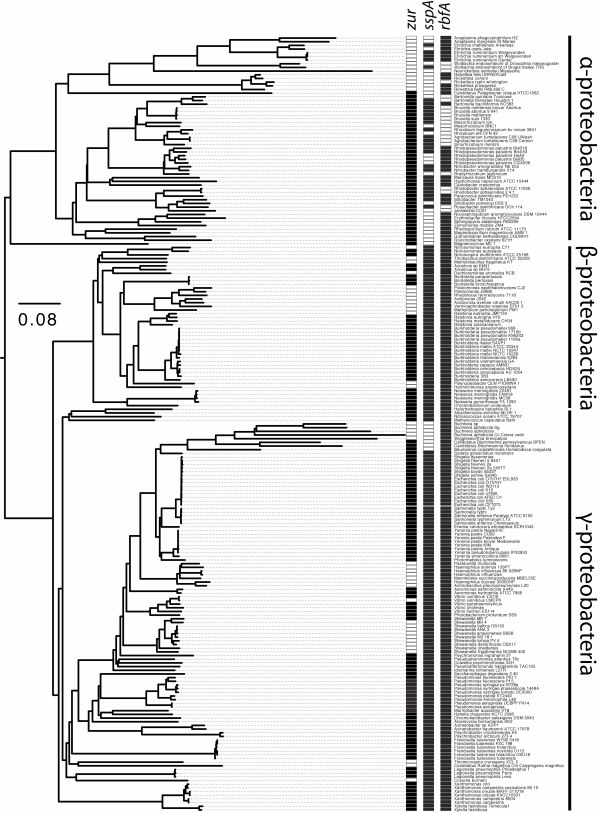Figure 5.
Phylogenetic pattern of conservation for zur, sspA, and rbfA. Unlike most RNA related genes (Fig. 5), these three genes have different patterns of conservation, and thus different ROL values, when compared between γ-β-proteobacteria and α-proteobacteria. The figure shows the phylogeny of the α-γ-β-proteobacteria together with Magnetococcus MC1, with the names of each taxa listed; this is a subset of the taxa presented in Figure S1. The columns show the conservation patterns for orthologues of the E. coli RNA related genes involved in information transfer (zur, sspA, and rbfA, respectively). Black boxes indicate orthologue presence, while white indicate absence. Orthologues of zur, a transcriptional regulator for zinc uptake, are almost completely conserved in α-proteobacteria, and were likely lost only a single time in the intracellular Rickettsia lineage. This can be contrasted with the pattern of conservation in the γ-β-proteobacteria, from which zur orthologues have been lost multiple times, and on relatively quick timescales: an orthologue appears in Shewanella sp. MR-7, but is absent from Shewanella sp. MR-4. Orthologues of sspA, associated with the RNA ROLymerase, are conserved almost completely in the γ-β-proteobacteria, having been lost only from the intracellular Candidatus-Buchnera lineage. However, in the α-proteobacteria sspA orthologues have been lost multiple times, and over short periods of time in some cases: an orthologue appears to be present in Mesorhizobium loti, but absent in Mesorhizobium BNC1. Finally, orthologues of rbfA, associated with the ribosome, are perfectly conserved in the γ-β-proteobacteria, but have been lost multiple times from the α-proteobacteria. The first case (zur) is consistent with an increased level of constraint within the α-proteobacteria, as this gene also has a high ROL value in the Bacilli-Mollicutes; in the case of rbfA, a relaxation in selective constraint within the α-proteobacteria seems likely, as orthologues of this gene are also highly conserved in the Bacilli-Mollicutes clade (sspA has no orthologues in the Bacilli-Mollicutes).

